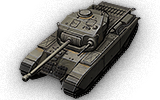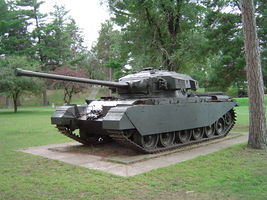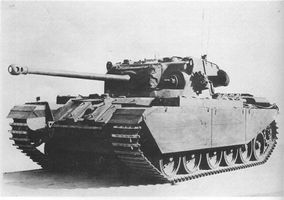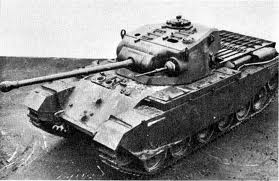Centurion Mk. I
GB23_Centurion (Stock)
| 2350000 價格 |
| 1350 血量 |
| 42.32 / 43 公斤重量 |
- 車長
| 76/51/38 前/側/後,毫米車身裝甲 |
| 127/76/76 前/側/後,毫米砲塔裝甲 |
| 600 匹馬力引擎功率 |
| 40 公里/小時最高時速 |
| 34 度/秒迴轉速度 |
| 140 標準砲彈殺傷力 |
| 148 毫米標準砲彈穿透力 |
| 4.2 炮管裝填 |
| 38 度/秒砲塔迴轉速度 |
| 380 公尺可視範圍 |
| 550 公尺訊號範圍 |

A notable step up from the Comet, featuring a great gun selection and still very agile, just like its predecessors, the Centurion Mk. I is a good tank for its tier. Although notably bulky and with spectacularly poor hull armor, it is quick on its feet and its 20-pounder gun features equally spectacular penetration and accuracy. It appears to have something of a weakness in that its ammunition rack and driver are both vulnerable to frontal hits. Fully upgraded though, it is a monster at long-range fighting and hill battles.
Compatible Equipment
Compatible Consumables
Player Opinion
Pros and Cons
Pros:
- 20 pdr. gun is arguably the best gun available for any tier 8 medium tank
- Maneuverability and acceleration
- Good hill climbing
- Great gun depression
- 2nd turret provides great protection
Cons:
- Poor hull armor
- Large size for a medium
- Low top speed
- Ammo rack is prone to damage
- Vulnerable to arty
Performance
Many would argue that it is with the Centurion Mk. I that the British mediums actually start to be able to compete. This tank is woefully under-armored on the hull, yet the cannons it has access to somehow make up for it - it has arguably the best gun complement of all Tier 8 medium tanks, being able to deal almost the same damage as a Panther II, while having more penetration, accuracy and better aim time. Even the 17-pounder (which you may research on the Black Prince) could be considered an adequate gun because of its higher DPM, provided that you can stand the low penetration.
The Centurion I is very much a long-range fighter, and thrives around hills. The reasons for this are self-evident; it is large and bulky for a medium, has atrocious hull armor, poor camouflage, and is prone to module and crew damage. However, thanks to its amazing guns, cannon depression and well-armored upgraded turret, it can make beautiful use of cover. Stock, you are going to have huge problems with performing if you do not already have the 17-pounder gun from the Black Prince. But, when fully upgraded and properly handled, this tank can support like none other at its tier.
Early Research
- If possible, research the 17-pounder on the Black Prince before acquiring this tank
- Upgrade the suspension
- Research the second turret
- Get the OQF 20-pounder A
- Upgrade remaining modules
Historical Info
Development history
The department responded by extending the long-travel five-wheel suspension used on the Comet with the addition of a sixth wheel and an extended spacing between the second and third wheels. The Christie suspension, with vertical spring coils between side armour plates, was replaced by a Horstmann suspension with external horizontal springs. The hull was redesigned with welded, sloped armour and featured a partially cast turret with the highly regarded 17 pounder as the main gun and a 20 mm Polsten cannon in an independent mounting to its left. With a Rover-built Rolls-Royce Meteor as used on the Comet and Cromwell, the new design would have excellent performance.
Shortly after the programme commenced, it became clear that the requirement to withstand 88 mm weapons would be impossible to meet within the permitted weight. The original specification had been set so that the A41 could be carried on the existing Mark I and Mark II transport trailers, which were limited to a 40-ton load. The War Ministry decided it would be wiser to build new trailers, rather than hamper what appeared to be a superb design. Even before prototypes of the original 40-ton design were completed, the design of a heavier version was well under way. The new version carried armour equal to the heaviest infantry tanks, and cross-country performance was superior to even the early cruiser tanks. The A41 was the first British tank that could "do it all", leading to the new designation "universal tank". The design mockup built by AEC Ltd was viewed in May 1944. Subsequently twenty pilot models were ordered with various armament combinations: ten with 17 pdr and 20mm Polsten gun of which half had a Besa machine gun in the turret rear and half an escape door, five with 17pdr and forward Besa and escape door, and five with QF 77mm gun and driver-operated hull machine gun. Prototypes of the original 40-ton design, the Centurion Mark I, had 76 mm of armour in the front glacis, which was thinner than the then current infantry tank designs such as the Churchill which had 101 mm, but the glacis plate was highly sloped and so the effective thickness of the armour was very high—a design feature shared by other effective designs such as the German Panther tank and Soviet T-34. The turret was extremely well armoured at 152 mm. The tank was also highly mobile, and easily outperformed the Comet in most tests. The uparmoured Centurion Mark II soon arrived; it had a new 118 mm-thick glacis and the side and rear armourhad been increased from 38 mm to 51 mm. Only a handful of Mk I Centurions had been produced when the Mk II replaced it on the production lines. Full production began in November 1945 with an order for 800 on production lines at Leyland Motors, Lancashire the Royal Ordnance Factories at Leeds and Woolwich, and Vickers at Elswick. The tank entered service in December 1946 with the 5th Royal Tank Regiment.
Soon after the Centurion's introduction, Royal Ordnance finished work on the Ordnance QF 20 pounder (84 mm) tank gun. By this point the usefulness of the 20 mm Polsten had been called into question, it being unnecessarily large for use against troops, so it was replaced with a Besa machine gun in a completely cast turret. The new Centurion Mark III also featured a fully automatic stabilisation system for the gun, allowing it to fire accurately while on the move, dramatically improving battlefield performance. Production of the Mk 3 began in 1948. The Mk 3 was so much more powerful than the Mk 1 and Mk 2 that the earlier designs were removed from service as soon as new Mk 3s arrived, and the older tanks were then either converted into the Centurion Armoured Recovery Vehicle (ARV) Mark 1 for use by the Royal Electrical and Mechanical Engineers or upgraded to Mk 3 standards. Improvements introduced with the Mk 3 included a more powerful version of the engine and a new gunsight and gun stabiliser. The 20 pounder gun was used only for a short time, until the Royal Ordnance Factories introduced the now legendary 105 mm L7 gun. All later variants of the Centurion, from Mark 5/2 on, used the L7. Design work for the Mk 7 was completed in 1953 with production beginning soon afterwards.
The Centurion was used as the basis for a range of specialist equipment, including combat engineering variants with a 165 mm demolition gun Armoured Vehicle Royal Engineers (AVRE). It is one of the longest-serving designs of all time, serving as a battle tank for the British and Australian armies from the Korean War (1950–1953) to the Vietnam War (1961–1972), and as an AVRE during the Gulf War in January–February 1991.
Historical Gallery
Sources and External Links
| Light Tanks | |
| Medium Tanks | |
| Heavy Tanks | |
| Tank Destroyers | |
| Self-Propelled Artillery |
| USA | |
| UK | |
| Germany | |
| USSR | |
| China | |
| Japan |


